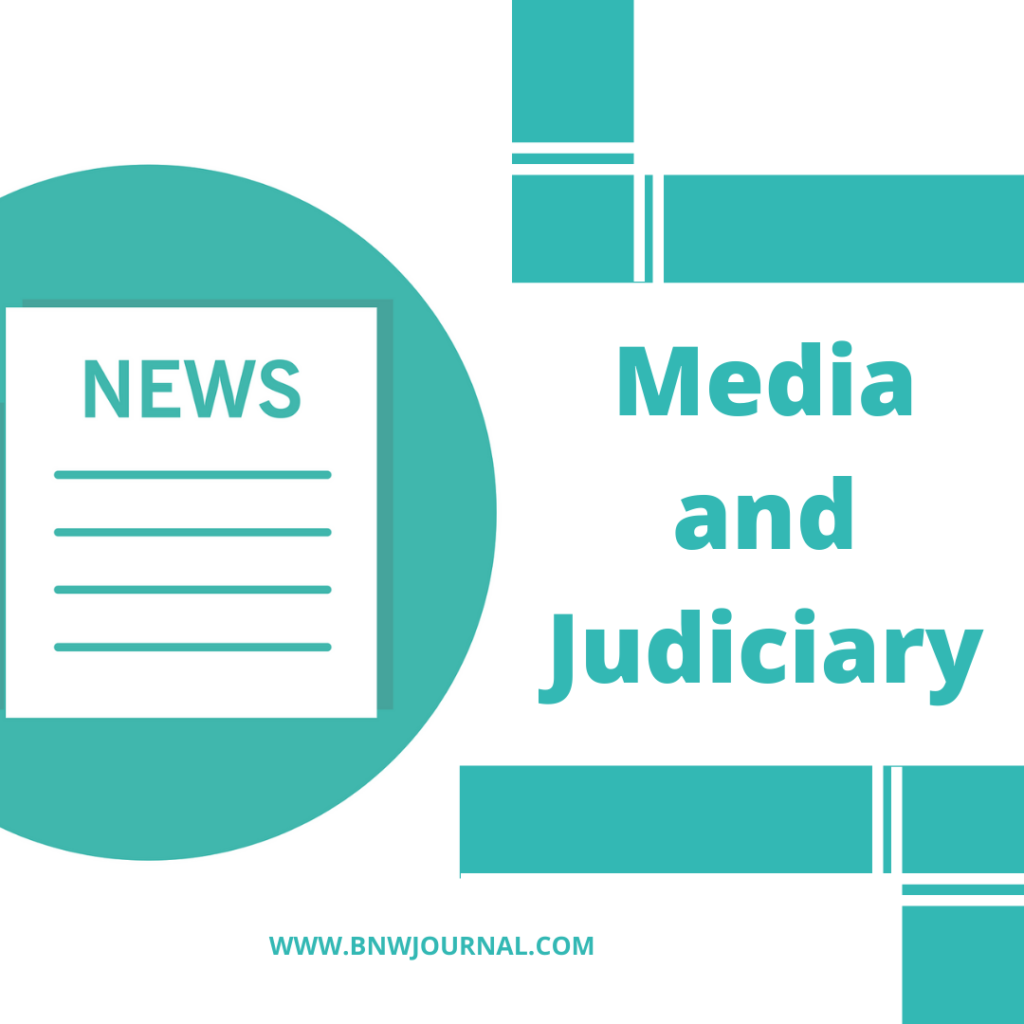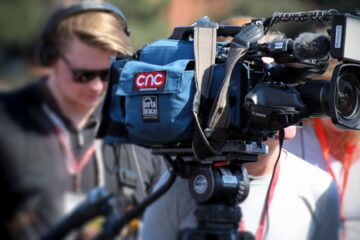![]()
Introduction
Media and judiciary is considered as two pillars of democracy, the media and the judiciary need each other and the public need both.

The media is the fourth limb of a democratic system, the legislature, executive and judiciary being the other three. While the legislature prepares the law for the society. The executive takes steps for implementing them. The third stepping-stone is the judiciary, which has to ensure the legality of all actions and decisions. The Fourth Estate i.e. the press has to operate within the framework of these statutes. And constitutional provisions to act in public and national interest.
This is indicative of the fact that nobody is above law. When the Constitution of India guarantee freedom of expression and speech to its citizens. It ensure that the freedom was not absolute and any expression. By way of words, speech or visual medium; did not violate any statutory provisions enacted by the legislature and executed by the executive. If the media, electronic or print, exceed its jurisdiction. The courts came forward to ensure that violation of the Fundamental Rights by the media does not go unchecked.
The Effects of Media on the Judgment Process
It can be universally agreed that the media is the best way in which the public learns about the judicial process. This can be written in relation to a newspaper article. Others such as television and radio videotapes will not be left out, this is especially applicable to designated frequencies. All this media coverage has so many different and unknown viewers with different interests. Some are interested in this case for their study purposes. While others seek to measure the institutions responsible for justice in a given country. The media may, however, supplement the idea by way of reporting.
The media is responsible for creating hype among the public in terms of how cases are presented. So media can get the public involved with the suspects as evidenced by the Rodney King case. Rodney King sets an example for us in how the media can play a role in influencing justice in the judicial process. This came from the recorded episodes of the police who beat him despite having no firearms and winning (Cannon, 1999). This report is of the view that injustice is done to the plaintiffs directly. As a result of an additional judicial incident.
The case of O.J Simpson’s trial illustrates a case in which the public has been interest in the case since the war. As a result of the media’s arrest. Simpson, a black man, had been accused of killing his white wife. And it was clear that racial groups in black and white were competing. The judge may have reached a guilty verdict in favor of race (Bigliosi, 1997). In addition, there is a tendency in the media to report cases involving celebrities other than high profile cases. Top newspapers and magazines and network news programs. Which were popular at night, during the Simpson trial. Provided limited space for those legal processes that had a high profile. For example, the JonBenet Ramsey murder investigation took only five minutes.
The judging process often attracts a lot of public attention because people want to be given details on the progress of the case. It is because of these anxieties that the media becomes useful; The media will forward the judging process and the public outlook regarding the decision reached by the judges. How often the media often influences the reception of the audience in relation to any given subject.
Many issues have arisen as a result of the debate over whether both television and electronic news can be disclosed. The purpose of the discussion is to strike a balance between the public’s access to this judicial process. The possible negative effects it can have on the court. Some of these emerging issues include the transparency of democratic structures. And democratic processes, due process, separation of powers, public education, security, and integrity in court proceedings. In light of these issues, it is clear that both supporters and opponents had their conflicts and defenses
Surgeons are of the view that the media will give the public the ability to reach judicial decisions more easily. According to them, it is constitutionally right for the right case to be assign to anyone, including complaints. He remembers this, therefore, the court should be extend to the public as a whole. This is possible only if the publication event has the freedom to collect and share information with different media.
Also, other proposals are to take that apart from the open steps that lead to a fair trial. Also to create democratic values in society (Martinez, 2009, 4). The court, in the proceedings of the Richmond Newspaper, Inc v. In Virginia in 1980, it proposed that without transparency it promotes the right to freedom of expression; in the same way it enhances the rights of criminal defendants as well as the rights of other due process groups.
Through the court proceedings by telephone judgment, justice is shown as transparent and open. This action is a manifestation of progress – based on nature. From listening to the public so that the public can easily access these processes. And consequently see that levels of clarification are raised in court and government performance at a broader level. Senator Patrick Leahy has similarly support that the court proceedings should not be block by the public. This transparency by announcing court decisions also has value for education.
Through broadcasting, the public receives the most valuable public lessons. This is a sense of community understanding in terms of the ways. Means that the courts of the organization conduct cases (Tonga, 2006). Announcing the proceedings in court protects the privacy and safety of those involved. The act of hiding the words and pictures of both themselves and witnesses makes security and privacy possible.
The plaintiffs also have their list of objections to the act of making the court process public. First, this move leads to an escalation of the conflict. Between the rights of a person who is being prosecute in court by an impartial. Other case guarantee in the First Amendment of the Nebraska Press Association v. Stuart in 1976. a court hearing can give birth to many rights issues, which are limited in certain circumstances. Besides, the television broadcast of state court proceedings may not jeopardize the fundamental rights of citizens. Basically to the appropriate judgment as one feels threaten.
As a result of the changing nature of the various appeals courts, the conference debated television programs. According to Jan DuBois, a United States District Court judge; who disseminates the District Court process will jeopardize the right to a fair. And fair trial because of its impact on witnesses, administrators and other parties. In his view, these poor cameras will override their beauty. The development of a negative impact on the court’s proceedings (Creech, 2007).
The use of cameras in the courts has also raised concerns about the issue of separation of powers. This is very clear in the decentralization of authority. Allowing the media to broadcast the proceedings in court. According to Justices Clarence Thomas and Antony Kennedy, would be inconsistent with the issue of high esteem among the various branches. They contend that the knowledge, power, and conditions of court proceedings are well understood by prisons. Therefore cameras should not be allow in these areas of the court.
Declaring court appearances also have the potential to cause misunderstandings. Because not everyone is well verse in the court system. The same television broadcast can lead to misconceptions of the courts. One of the functions of the court is the role of the judges in private practice. Including reading, writing, and analyzing books and books. All this has to be before re-imagining conferences with other judges. Progress in a court case can lead to a loss of a degree of anonymity on the part of the judges. Leading to a reduction in privacy.
Besides, these significant losses will present security-related issues. Security is a major issue, not only from the perspective of judges. But from other role players such as witnesses, prosecutors, lawyers, and court personnel; who participate in criminal and civil cases (Tonga, 2006). Security problems were further exacerbate by the late arrivals of judges and court staff. Besides, they have also received death threats. Therefore, the television broadcast of pictures of the hearing judges and the decision-making of various criminal cases. It makes them more open and thus more vulnerable to criminal conflicts.
This is based on the fact that these court employees can easily be identified. On the witness side, the broadcast means that their private information is to the general public and this could lead to their intimidation. Also, the potential consequences can be embarrassing or unwilling to testify at any hearing.
Although both sides are present, a central point must be point out to ensure that neither one is pressing the other. In the above analysis of electronic deposits and telecommunications in court. It is undeniable that the attempt was not intend to constitute entertainment without resorting to the court. Much of the broadcast is not usually of public interest and or drama. But it presents the facts of court cases in a way that is easily understood. Besides, some overlap is often very informative as they provide the actual rule, procedure, and penalties (Vision & Ertter, 2002).
Compared to television, newspapers appear to be more inclined to mimic themselves. Focusing their attention on the sensory elements, and reporting the phenomenon. This is because journalists of these journals have a lot of space to include detailed information. Notable; however, the fact that the use of cameras in the courts encourages more media coverage in comparison to the media.
The media should never be incline to rely heavily on evidence that can be fabricate by a defendant. This should be consider with caution. Because even some people who make up the audience may have their own decision of the defendant’s case against the judge’s position. In the same way, having cameras in the courts can lead to the spread of apartheid. Reporters are caught up in imitation reports as they will be interest in those parts of the case that will not make him explain what happen. On the other hand, the absence of the camera may lead to increasing the journalist’s descriptions of the case. Without merely making the same summary.
Having cameras in courtrooms plays a huge role in agency matters. The unavailability of videos by journalists makes the expansion of the focus of the case far beyond the court walls. Therefore, various mechanisms must be put in place. It is to determine whether the law relating to the banning of electronic and television news is not a major departure from court hearings. Alternatively; to conceal faces, photographs, or even the voices of various witnesses and administrators during the compilation of electronic media especially in the union.
The media played a very important role in providing the general public with academic reporting. On everything that happen during the court proceedings. News coverage should be design to be in line with the rules of the judicial system built to ensure justice is serve. Criminal cases include participants’ interests in their organizations who misbehave in their conduct. The media may intimidate or expose stakeholders to future insecurity. In the past, media reporting has presented difficulties as the various stakeholders have had some impact. Measures to ensure the distribution of media must be institute to protect the sanctity of the judicial process.
The Need To Regulate Unhealthy Media Activism
The judiciary is not free from human follies
Every holder of judicial office indeed does his utmost not to let his mind be affect by what has seen or heard or read outside the court and he will not knowingly let himself be influence in any way by the media. At the same, it is to be kept in mind that judges being humans are not free from faults. A man may not be able to put that which he has seen, heard, or read entirely out of his mind; and he may be affect by it. The judiciary is not independent unless the Courts of Justice can administer the law in the absence of the pressure of popular opinion.
If one carefully analyses the judgment in Reliance Petrochemicals v. Proprietor of Indian Express in the light of the judgment of P.C. Sen, it can be inferred that the Supreme Court has accepted that Judges are likely to be “subconsciously influenced” by the media publicity. The same view has been held by Justice Frankfurter of the U.S. Supreme Court and Lord Scarman and Lord Dilhorne in the House of Lords.
Justice Frankfurter in the case of John D. Pennekamp v. State of Florida has observed:
“No Judge fit to be one likely to be influenced consciously except by what he sees or hears in Court and by what is judicially appropriate for his deliberations. However, judges are also human and we know better than did not forbear how powerful is the pull of the unconscious and how treacherous the rational process…and since Judges, however stalwart, are human, the delicate task of administering justice ought not to be made unduly difficult by irresponsible print.
The power to punish for contempt of court is a safeguard not for judges as persons but for functions that they exercise. It is a condition of that function –indispensable in a free society –that in particular controversy pending before a court and awaiting judgment, human beings, however strong, should not be torn from their mooring of impartiality by the undertone of extraneous influence. In securing freedom of speech, the Constitution hardly meant to create the right to influence Judges and Jurors.”
Several other reports have also suggested that the judges are likely to get influenced by the stories published and broadcasted by the media houses. Cardozo, one of the greatest Judges of the American Supreme Court, in his Nature of the Judicial Process referring to the forces which enter into the conclusion of the judges observed: “the great tides and currents which engulf the rest of the men, do not turn aside and pass the Judges by”. The Canadian Law Reform Commission has taken the view that while judges may generally be impervious to influence, the possibility of such influence could not be ruled out altogether, and in the case of Judicial officers, the sub-judice rule served an important function of protecting the public perception of impartiality.
In a case where a woman committed suicide in Calcutta in her parents’ house, the husband of the deceased woman and his family were charged with dowry death under the Indian Penal Code. The husband subsequently filed a number of documents to prove that the woman was a schizophrenic psychotic patient, while the parents of the woman filed documents to prove their allegations of demand of dowry by the husband and his family. The trial was yet to commence. The lower courts refused to grant bail.
Later the Supreme Court granted interim bail to the accused and while passing the final orders referred very critically to certain news items in a magazine. The Court deprecated two articles published in the magazine in a one-sided manner setting out only the allegations made by the woman’s parents but not referring to the documents filed by the accused to prove that the lady was schizophrenic. The apex Court observed, “These types of articles appearing in the media would certainly interfere with the course of administration of justice”.
There must be regulations with regard to publications and news programs while a trial is going on. It is just as important to protect the public perception of judges’ impartiality as to protect the risk of bias. After all we cannot forget the Common rule Law laid down in R v. Sussex Justices: Exparte McCarthy that “Justice should not only be done, it should manifestly and undoubtedly be seen to be done”.
Fair Trial and Trial by Media
Our criminal law requires that the guilt of a person be proved beyond reasonable doubt and the accused is presumed to be guilty unless the contrary is proved in a court of law, observing all the legal safeguards to an accused. The media people have in many cases acted as self-proclaimed judges.
Parties have a constitutional right to have a fair trial in the court of law, by an impartial tribunal, uninfluenced by newspaper dictation or popular cry. Fairness and justice are two main basements on which the entire democratic structure rests. Denial of fair trial can be understood as the obstruction or interference in the administration of justice to a person facing trial. The prejudicial publication against the accused amounts to denial of a fair trial.
The question in all cases of comment on pending proceedings is not whether the publication does interfere, but whether it tends to interfere, with the due the course of justice. In Anukul Chandra Pradhan v. Union of India, the Supreme Court observed that “No occasion should arise for an impression that the publicity attached to these matters has tended to dilute the emphasis on the essentials of a fair trial and the basic principles of jurisprudence including the presumption of innocence of the accused unless found guilty at the end of the trial.” The trial by a press, electronic media, or by way of public agitation is the very antithesis of the rule of law and can lead to a miscarriage of justice. The liberty of the press is subordinate to the administration of justice.
Violation of Human Rights
The responsibility of the media is greater than the responsibility of an individual because the media has a larger audience. The freedom of the press should neither degenerate into a license to attack litigants and close the door of justice, nor can it include any unrestricted liberty to damage the reputation of respectable persons.
The infringed privacy and tainted reputation of certain persons has become an inevitable byproduct of extra snooping done by media. Suspects and accused apart even the victims and witnesses suffer from excessive publicity and invasion of privacy rights. In the famous Jessica Lal Murder case,[xii] where Manu Sharma was tried and convicted for murder, the court held that “There is danger, of serious risk of prejudice if media exercises an unrestricted and unregulated freedom such that it publishes photographs of the suspects or the accused before the identification parades are constituted or if media publishes statements which out rightly hold the suspect or accused guilty even before such an order has been passed by the court.”
In the aforementioned case, certain articles immediately after the date of occurrence confused the mind of the public as to the description and number of actual assailants/suspects. It is not fair to cause taint to the reputation of a person by creating a widespread perception of guilt, regardless of any verdict in a court of law. In the recent times, a congress minister in the coalition Government of Jammu and Kashmir had to resign after revelations of his sexual advances and molestation became public. Tarun Tejpal and Justice AK Ganguly were in the dock for the same reason. Such kinds of ‘Trial by Media’ have become common and rife after deregulation of the media and proliferation of visual media.
It is not fair to taint the reputation of a person by creating a widespread perception of guilt, regardless of any verdict in a court of law. The suspect gets negative publicity and later even if the court finds him innocent, his future remains uncertain because of the stories cooked up by the media.
The security of the witnesses is also often jeopardized by irresponsible reporting. If the identity of the witness is published, there is a danger of him coming under pressure both from the accused or his associates. This is one of the main reasons why almost everyone is hesitant to report a crime or appear as a witness. With the unfettered interference of the media, each witness wants to retract and get out of the muddle. Sting operations are conducted to point out the lacuna in investigations and trials much before the investigation or trial has progressed considerably. This affects the morale of the police and other investigation agencies. The police are often made a scapegoat. The over-enthusiastic media often puts a lot more pressure than required on the police to speed up the investigation. Speedy investigation under pressure can lead to the arrest of innocent persons.
Conclusion
It has to be remembered that freedom of expression is not absolute, unlimited, or unfettered. The judiciary is peopled by human judges, and being human they are occasionally motivated by considerations other than an objective view of law and justice. No judge is completely impervious from the influence of the hype created by the media.
The media must exercise better self-regulation. It is expected of persons at the helm of the affairs in the field of media to ensure that the trial by media does not hamper the fair investigation by the investigating agency, and more importantly does not prejudice the defense of the accused in any manner whatsoever. It will amount to travesty of justice if either of these causes impediments in the accepted judicious and fair investigation and trial.
To stifle free speech and comments on the court, even an occasional exercise of the power of the court to punish the condemners is enough to deter most persons from saying anything that might prejudicially affect any trial proceeding or tend to transgress the natural justice principles.
If the government starts regulating the media, the whole purpose would be defeated. Instead the better option would be robust and civic engagement by the people with their polity and political class. In other words the engagement that is both adversarial and co-operative. An educated, cultivated and engaged civil society can be the best watchdog over governments and the media. This would restore and balance the polity and accord a semblance of normalcy among the institutions of the country.



0 Comments